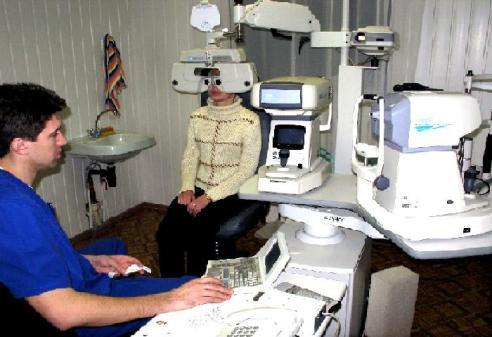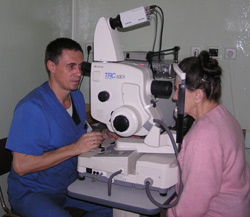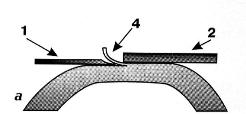Equipment
 The department is provided with up-to-the-minute diagnostic and surgical equipment
produced by Japanese manufacturers (up to the best Moscow clinics standard), including
the computerized diagnostic line, four surgical laser laser facilities among which
there is an excimer laser NAVEX system of the Japanese NIDEK firm as well as modern
therapeutical laser and electrostimulating facilities.
The department is provided with up-to-the-minute diagnostic and surgical equipment
produced by Japanese manufacturers (up to the best Moscow clinics standard), including
the computerized diagnostic line, four surgical laser laser facilities among which
there is an excimer laser NAVEX system of the Japanese NIDEK firm as well as modern
therapeutical laser and electrostimulating facilities.
|
Basic purposes and abilities of the department :
1. Conducting complicated hardware-controlled diagnostic studies.
 The following studies are performed: autorefractokeratometry, keratotopographical studies, ultrasound A-scanning,
B-scanning, fit of correction using computer phoropter, biomicroophthalmoscopy with
the Goldman lens.
The following studies are performed: autorefractokeratometry, keratotopographical studies, ultrasound A-scanning,
B-scanning, fit of correction using computer phoropter, biomicroophthalmoscopy with
the Goldman lens.
|
2.Carrying out conservative laser, hardware-controlled techniques of treatment :
The following techniques are carried out: laser pleoptics, laser stimulation of cornea,
laser stimulation of lacrimal gland, laser stimulation of retina, laser phoresis of
medicinal agents, quantum photomodulation of blood using transcutaneous technique,
transpalpebral electrostimulation, transcranial electrostimulation.
3.Carrying out operative laser techniques of treatment:
 The laser operative interventions on anterior segment are performed: laser puncture
of cysts,capsulotomy, membranotomy, synechiotomy, coreopraxis;
The laser operative interventions on anterior segment are performed: laser puncture
of cysts,capsulotomy, membranotomy, synechiotomy, coreopraxis;
in glaucoma: laser iridectomy, iridoplasty, trabeculoplasty, descemethogoniopuncture;
on vitreous humor: vitreolysis, adhesiotomy between vitreous humor and retina;
in retina diseases: focal, paravasal, sectoral, panretinal, “lattice”, barrier,
preventive peripheral laser coagulation of retina, laser retinotomy (of laceration
valves), subthreshold phototherapeutical laser coagulation of retina.
|
4.Refractive laser surgery.
 In 2003 thanks to the TFOMS sponsorship in the network of Governor program our clinic
was provided with the universal excimer laser NAVEX system of the NIDEK firm in
combination with the keratotopographer OPD Scan ARC 10000 and microkeratom ÌÊ-2000
for conducting laser refractive surgery.
In 2003 thanks to the TFOMS sponsorship in the network of Governor program our clinic
was provided with the universal excimer laser NAVEX system of the NIDEK firm in
combination with the keratotopographer OPD Scan ARC 10000 and microkeratom ÌÊ-2000
for conducting laser refractive surgery.
|
Excimer laser equipment is used for performiong corrections of widely spread among
the population anomalies of refraction – myopia, astigmatism, hypermetropia including
the cases which fail to be corrected by traditional means of using glasses. Besides,
excimer laser operative interventions are performed in a number of cornea diseases
(leukomas, persisting ulcers, recurrent pterygiums etc.).
We use the most perfect at the present time LASIK (Laser Assisted in Situ Keratomileusis)
technique – laser keratomilles. During laser keratomilles the surface layers of cornea
(130-160 microns) by the instrumentality of a special implement named microkeratom are
pared figure-of- pedicle flap, then by means of an excimer laser we evaporate the
inner substance of cornea in order to fashion it into necessary form and curvature
(figure 1). Then the flap is put on its place and due to the thinness of the cut it
adheres very soon without stitches. An operation like this makes it possible to shorten
the recovery period to a few days and is almost totally deprived of side effects and
complications.
 |
à) paring the surface flap of cornea which is 130-160 micrometers thick
(1 - knife, 4 - flattening plate of microkeratom);
|
 |
á) ablation of the cornea stroma (3 – the cornea cut bed, 4 – the surface flap of cornea);
|
 |
â) irrigation of the bed and putting the flap on its place (4 – the change of cornea profile can be seen).
|
The LASIK operation (also its modifications LASEK, FAREK, REIK et al. are performed)
makes it possible to improve virtually myopia and astigmatism of any degree. Besides,
there exists a possibility of all types of irregular astigmatism correction as well as
postoperative defects left after the operations wich had bee performed earlier, including
those performed unsuccessfullly in previous years of radial keratotomy. Pro hac vice
we use exacting equipment including OPD- scanner of optical tract, autorefkeratometer,
automatic phoropter, keratopachymeter and excimer laser facility of the last generation
NAVEX produced by the Japanese firm NIDEK with automatic microkeratom.
Before conducting the laser refractive operation the patients undergo a thorough diagnostic
inspection of the eyes including both general techniques of the anterior segment of eye
and eye grounds examination and special hardware-controlled estimation of all cornea
parameters – for more exact calculation of all parameters of the forthcoming operation.
If some dystrophic changes of retina are revealed in a patient, which are likely to cause
future complications, firstly the strengthening of retina is performed with the usage of
another laser (laser coagulator). After that the performance of the vision-correcting
excimer operation is possible only within 15-20 days.
After performing the refractive operation the patients living in town may go home with
obligatory examination on the second day; patients from other towns may be admitted into
the hospital for 1-2 days. During the postoperative period it is obligatory to instill
eye drops preventing occurrence of inflammatory complications; it is also necessary
to observe quite simple rules and restrictions for a month time.
Visual functions are restored to normal almost immediately after the operation but the
maximum effect and stabilization of vision occurs in 3-6 months later. In case of myopia
of very high degree, a two phases operation may be required.
Excimer laser correction of vision is characterized by long-term effect persistence and
very low incidence of complications, which are mostly of transient (temporal) character.
Additional directions of the department work:
Conservative methods of progressive myopia prophylaxis in children are also practiced –
carrying out stimulatory courses of treatment with the usage of up-to-date therapeutic
laser and electrostimulating apparatuses.
Most common pathologies in which therapeutic-diagnostic assistance is rendered in the laser center:
Ìyopia, hypermetropia, astigmatism, amblyopia, keratitis, iridocyclitis, secondary cataract,
glaucoma, vascular and dystrophic diseases of retina (including diabetic retinopathy),
central serous chorioretinopathy, laceration and detachment of retina.
Paid services available:
- Consultative reception of patients.
- Conducting complicated hardware-controlled diagnostic examinations.
- Carrying out conservative methods of laser treatment.
- Carrying out out-patient surgical operative laser treatment techniques.
- Performing excimer laser correction of vision in myopia, hypermetropia, astigmatism.
| Phone in Voronezh |
(4732)52-11-26 |
| Local |
10-01, 10-03 |
|
The information renewal date - 18.10.2010
|